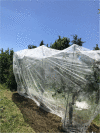Recent Developments and Strategies for the Application of Agrobacterium-Mediated Transformation of Apple Malus × domestica Borkh
- PMID: 35845652
- PMCID: PMC9280197
- DOI: 10.3389/fpls.2022.928292
Recent Developments and Strategies for the Application of Agrobacterium-Mediated Transformation of Apple Malus × domestica Borkh
Abstract
Genetic transformation has become an important tool in plant genome research over the last three decades. This applies not only to model plants such as Arabidopsis thaliana but also increasingly to cultivated plants, where the establishment of transformation methods could still pose many problems. One of such plants is the apple (Malus spp.), the most important fruit of the temperate climate zone. Although the genetic transformation of apple using Agrobacterium tumefaciens has been possible since 1989, only a few research groups worldwide have successfully applied this technology, and efficiency remains poor. Nevertheless, there have been some developments, especially in recent years, which allowed for the expansion of the toolbox of breeders and breeding researchers. This review article attempts to summarize recent developments in the Agrobacterium-mediated transformation strategies of apple. In addition to the use of different tissues and media for transformation, agroinfiltration, as well as pre-transformation with a Baby boom transcription factor are notable successes that have improved transformation efficiency in apple. Further, we highlight targeted gene silencing applications. Besides the classical strategies of RNAi-based silencing by stable transformation with hairpin gene constructs, optimized protocols for virus-induced gene silencing (VIGS) and artificial micro RNAs (amiRNAs) have emerged as powerful technologies for silencing genes of interest. Success has also been achieved in establishing methods for targeted genome editing (GE). For example, it was recently possible for the first time to generate a homohistont GE line into which a biallelic mutation was specifically inserted in a target gene. In addition to these methods, which are primarily aimed at increasing transformation efficiency, improving the precision of genetic modification and reducing the time required, methods are also discussed in which genetically modified plants are used for breeding purposes. In particular, the current state of the rapid crop cycle breeding system and its applications will be presented.
Keywords: Agrobacterium tumefaciens; Malus; apple; genome editing; rapid cycle breeding; transformation; virus-induced gene silencing.
Copyright © 2022 Schröpfer, Lempe, Emeriewen and Flachowsky.
Conflict of interest statement
The authors declare that the research was conducted in the absence of any commercial or financial relationships that could be construed as a potential conflict of interest.
Figures





Similar articles
-
Agrobacterium tumefaciens-Mediated Stable Transformation of Malus domestica (Apple) cv Fuji Raku Raku and Royal Gala.Methods Mol Biol. 2025;2911:133-142. doi: 10.1007/978-1-0716-4450-8_13. Methods Mol Biol. 2025. PMID: 40146516
-
In vitro tissue culture of apple and other Malus species: recent advances and applications.Planta. 2019 Apr;249(4):975-1006. doi: 10.1007/s00425-019-03100-x. Epub 2019 Feb 20. Planta. 2019. PMID: 30788577 Review.
-
Boosting carotenoid content in Malus domestica var. Fuji by expressing AtDXR through an Agrobacterium-mediated transformation method.Biotechnol Bioeng. 2020 Jul;117(7):2209-2222. doi: 10.1002/bit.27358. Epub 2020 May 4. Biotechnol Bioeng. 2020. PMID: 32311081
-
Transformation of apple (Malus × domestica) using mutants of apple acetolactate synthase as a selectable marker and analysis of the T-DNA integration sites.Plant Cell Rep. 2013 May;32(5):703-14. doi: 10.1007/s00299-013-1404-7. Epub 2013 Mar 15. Plant Cell Rep. 2013. PMID: 23494389
-
Transient plant transformation mediated by Agrobacterium tumefaciens: Principles, methods and applications.Biotechnol Adv. 2015 Nov 1;33(6 Pt 2):1024-42. doi: 10.1016/j.biotechadv.2015.03.012. Epub 2015 Mar 25. Biotechnol Adv. 2015. PMID: 25819757 Review.
Cited by
-
Agrobacterium rhizogenes: paving the road to research and breeding for woody plants.Front Plant Sci. 2023 Nov 14;14:1196561. doi: 10.3389/fpls.2023.1196561. eCollection 2023. Front Plant Sci. 2023. PMID: 38034586 Free PMC article. Review.
-
Isoenzymes of the Flavonoid and Phenylpropanoid Pathways Show Organ-Specific Regulation during Apple Fruit Development.Int J Mol Sci. 2023 Sep 20;24(18):14353. doi: 10.3390/ijms241814353. Int J Mol Sci. 2023. PMID: 37762656 Free PMC article.
-
MdAIL5 overexpression promotes apple adventitious shoot regeneration by regulating hormone signaling and activating the expression of shoot development-related genes.Hortic Res. 2023 Oct 10;10(11):uhad198. doi: 10.1093/hr/uhad198. eCollection 2023 Nov. Hortic Res. 2023. PMID: 38023483 Free PMC article.
-
Transcriptomic Analysis of the Negative Effect of Epigallocatechin-3-Gallate from Tea Plant (Camellia sinensis) on Agrobacterium-Mediated Transformation Efficiency.Curr Issues Mol Biol. 2025 Mar 8;47(3):178. doi: 10.3390/cimb47030178. Curr Issues Mol Biol. 2025. PMID: 40136432 Free PMC article.
-
Establishment of an Efficient Agrobacterium rhizogenes-Mediated Hairy Root Transformation System for Functional Analysis in Passion Fruit.Plants (Basel). 2025 Jul 26;14(15):2312. doi: 10.3390/plants14152312. Plants (Basel). 2025. PMID: 40805662 Free PMC article.
References
-
- AGDH (2022). Australian Government Department of Health. Available at: https://www.ogtr.gov.au/what-weve-approved (Accessed March 7, 2022).
Publication types
LinkOut - more resources
Full Text Sources
Miscellaneous

